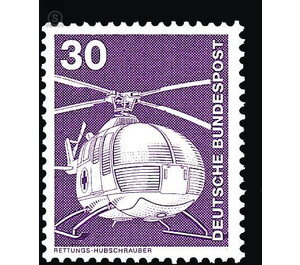Postage stamps: industry and technology - Germany / Federal Republic of Germany 1975 - 30 Pfennig
Theme: Post & Philately
| Country | Germany / Federal Republic of Germany |
| Issue Date | 1975 |
| Face Value | 30.00 |
| Color | violet |
| Perforation | K 14 |
| Printing Type | Typography |
| Stamp Type | Postage stamp |
| Item Type | Stamp |
| Chronological Issue Number | 738 |
| Chronological Chapter | GER-BRD |
| SID | 509682 |
| In 197 Wishlists | |
A new postage stamp continuous series with representations from industry and technology replaces the postage stamp continuous series "Federal President Heinemann". The postage stamps of 10 Pfennig, 30 Pfennig and 70 Pfennig appear as further values of this series with the inscription Deutsche Bundespost (at the same time and same motives the stamps also come out with the inscription Deutsche Bundespost Berlin, the first three values were issued on May 15, 1975 ) carry the following motifs: 30 Pf: rescue helicopter Shown is the helicopter MBB BO 105, which was developed for a wide range of applications, such. For general missions, passenger transport, search and rescue missions, medical missions, general police security and regulatory tasks, etc. In addition to the pilot's seat, seats are provided for four people. Two standard straps can be stored in the cargo compartment when the rear seat is removed. Special precautions can be taken for additional equipment to perform rescue, police missions etc. The development concept for this helicopter was based on a 1961/62 by the then Bölkow GmbH elaborated market study on the helicopter use in the seventies and eighties. The best prospects opened up for a five-seat rotorcraft with a take-off weight of 2,000 kg. Thus, the design of the BO 105 was clear: five seats and sufficient cargo space with the aim of outperforming all others in its class; two turbine engines to be the first light helicopter in the world to achieve the ability to fly blind and to provide greater safety for flights over large cities and waters. The development of a jointless rotor system with GfK blades (glass fiber reinforced plastic) used for the first time was recognized as a prerequisite for better dynamic stability, better controllability and considerably simpler design and maintenance. The cruising speed should be 240 km / h and the range about 650 km. The use of turbine engines has been taken for granted from the beginning because of its low power-to-mass ratio over piston engines. A possibly lying in the center of gravity cargo space was one of the determining factors for the design of the cell. A high tail rotor should provide safe access from the rear as well as landings on uneven or overgrown terrain. All these requirements were met or exceeded in the construction of the BO 105. The Federal Aviation Office issued the type approval for the B 105 A in October 1970. In the same month, the first production aircraft were delivered to the ADAC, the Bavarian Red Cross and the Bavarian police. Today, BO-105 rescue helicopters are already flying in many countries around the world.


